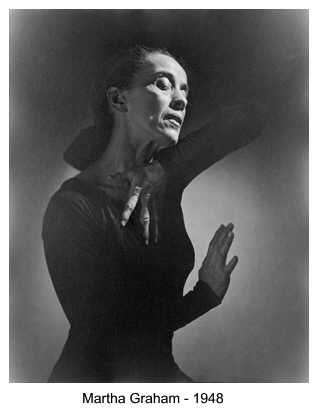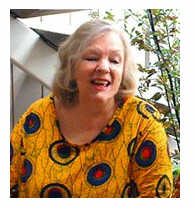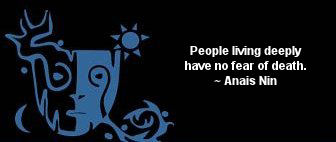|

Martha Graham:
A Dance of Death and Life
© 2008 by Maggy Anthony
 "'I don't know what keeps her going'. Nothing did... She didn't keep going. She barely existed. Martha went into hell." 1. "'I don't know what keeps her going'. Nothing did... She didn't keep going. She barely existed. Martha went into hell." 1.
This would seem to have heralded the end of Martha Graham, a name synonymous with the modern dance movement of the Twentieth century. And it almost did.
At seventy-two years old, on May 25, 1968, Graham gave her last dance performance, a performance revealing an exhausted, heavy drinking old woman, well past her prime. She was dancing for her life; each dance a dance of destruction to counter her enormous fear. "I'd rather die," she said. "I would die if I stopped. I cannot go on without dance." 2.
Those around her, friends and company members, feared she would take her reputation and company with her if she did not stop performing. She had become a parody of her young self on stage. Friends and associates tried to intervene with her, to make her listen to reason. She raged against them and continued to dance.
They suggested she continue to choreograph, but stop dancing. She protested that she had never wanted to choreograph, it was dancing that was her life.
With that final performance, aptly titled "A Time of Snow", shortly after the curtain fell, Graham entered the hospital , sick in body and in spirit. Martha had descended into the belly of the whale, and there were few who believed she would be able to emerge. She seemed to have lost the strength, perhaps even the desire to live, if she couldn't dance. Joseph Campbell has written of this condition in his seminal work of mythology, "The Hero with a Thousand Faces". "And it so happens ... that if anyone undertakes for himself the perilous journey into the darkness by descending, either intentionally or unintentionally, into the crooked lines of his own spiritual labyrinth, he soon finds himself in a landscape of symbolical figures, anyone of which may swallow him."3.
And it was there that the return from the deep loss began. A young man, an avid fan, showed up at her bedside one evening. Martha needed to go to the bathroom, but was too weak to walk and rang for a nurse. None was available. The young man picked her up in his arms and carried her to the bathroom. She was embarrassed to be seen so weak and vulnerable. But this simple act signaled the turn around of her life from loss to renewal.
Much has been written, both pro and con, about the influence of Ron Protas, the young man, on the last years of Martha Graham. Lawsuits have raged on, back and forth since her death, only recently coming to a definitive end to the fight for control of the rights to her choreography and company. The fact remains, with the advent of this young man into her life, and his support, Graham rallied and went on to more triumphs both personally and as an innovative choreographic genius. With her knowledge of the ancient myths, perhaps she saw him as the advent of Dionysus into her life. Often a figure like this appears in the later life of creative women.
She once wrote, "There is a wonderful Icelandic expression, 'doom-eager'. You are doom eager for destiny no matter what it costs you." 4.
This was undoubtedly true for Graham whose ancestors were among the first settlers of this country, coming as strict Puritans who held dancing to be a major sin. She danced against this and the title of her first major piece, "Heretic", indicates her blood knowledge of the roots. "... I was a heretic. A heretic is a woman ... who is frightened. Every place she goes, she goes against the heavy beat and footsteps of those she opposes."5.
Early on, Martha sensed the importance of myth. Her notebooks are filled with mythological references as she planned her dances. She read everything to do with myth from Joseph Campbell to T.S.Eliot. Myth was both implicit and explicit in everything she choreographed. 6.
Once she accepted the help of Protas and other friends like the designer, Halston, who appeared to help her restoration of herself, she went on to even greater fulfillment of her creative genius. The business of reparation must always start with ourselves, no matter who, or what sparks the process. Ultimately we must make the decision to return, to repatriate ourselves as it were, from the abyss into which we have fallen.
Graham did this. After an initial reluctance to go on, she took part in the reinvention of herself. Costuming, both for herself and her troupe, even plastic surgery, was part of the process and she participated enthusiastically as she was transformed into an icon. All of this was in the service of her doom-eager yearning to have her genius recognized and accepted.
A review of her piece, "The Rite of Spring" perhaps sums it up best. "If one did not know the choreographer, one would simply be awed by the imagery and authority of this work. It is more satisfying still to recognize it as a synthesis of many aspects of Graham's investigations into dance, theatre, and universal stories, and one can't help rejoicing in the personal triumph, to have created, at 90, a work fit to take its place among one's best." 7.
NOTES
- 1. Martha: The Life and Work of Martha Graham, Agnes de Mille, Random House 1991 p.365
- 2. Ibid. p.373
- 3. The Hero with a Thousand Faces, Joseph Campbell, Princeton University Press, Princeton, New Jersey 1949
- 4. Blood Memory Martha Graham, Doubleday, 1991 p. 118
- 5. Ibid p 114
- 6. The Notebooks of Martha Graham, Martha Graham, Harcourt Brace Jovanovich, New York 1973
- 7. Martha: The Life and Work of Martha Graham, Agnes de Mille, Random House, New York, 1991, p.404
 Maggy Anthony it the author of Jung's Circle of Women: The Valkyries (Jung on the Hudson Books) Maggy Anthony it the author of Jung's Circle of Women: The Valkyries (Jung on the Hudson Books) , Landscape of Desire , Landscape of Desire , and Impossibly Blonde: The Genesis of a Play in the Death and Funeral of Marilyn Monroe , and Impossibly Blonde: The Genesis of a Play in the Death and Funeral of Marilyn Monroe . She attended the Zurich Jung Institute in the 70s. Since then she has taught mythology, Jungian psychology and myth at places as diverse as Esalen Institute, and the Center for Living Well in Reno. . She attended the Zurich Jung Institute in the 70s. Since then she has taught mythology, Jungian psychology and myth at places as diverse as Esalen Institute, and the Center for Living Well in Reno.
"I received a minor initiation into Umbanda,while living in Rio de Janeiro for two years," said Anthony. "It was my introduction to Yemaya, named Iemanja in Brazil. I had been looking for a spiritual connection since I was eighteen, and when in Brazil, found it in the attachment to this Yoruba deity, who chose me during a ceremony where I had gone merely as a spectator. A fictionalization of this event occurs in one of the stories in my collection, Landscape of Desire. It has had a profound impact in my life, and when I came home from the Jung Institute years later, I taught the history and impact of the Goddess at Esalen Institute in San Francisco, then went on and tauight similar classes all over the Western United States in the late 70s, 80s and into the 90s."
Read more about Maggy Anthony at her website pahrahdiseonline.com
Return to Mythic Passages Menu
Subscribe to the Mythic Passages e-magazine
|

